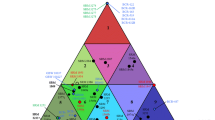Abstract
Well-characterized certified reference materials are needed by laboratories in the food testing, dietary supplement, and nutrition communities to facilitate compliance with labeling laws and improve the accuracy of information provided on product labels, so that consumers can make good choices. As a result of the enactment of the Nutrition Labeling and Education Act of 1990 and the Infant Formula Act of 1980, the National Institute of Standards and Technology (NIST) worked to develop a series of food-matrix standard reference materials (SRMs) characterized for nutrient concentrations. These include SRM 1544 Fatty Acids and Cholesterol in a Frozen Diet Composite, SRM 1546 Meat Homogenate, SRM 1548a Typical Diet, SRM 1566b Oyster Tissue, SRM 1846 Infant Formula, SRM 1946 Lake Superior Fish Tissue, SRM 1947 Lake Michigan Fish Tissue, SRM 2383 Baby Food Composite, SRM 2384 Baking Chocolate, SRM 2385 Slurried Spinach, and SRM 2387 Peanut Butter. With the enactment of the Dietary Supplement Health and Education Act of 1994, NIST has been working to develop suites of dietary supplement SRMs characterized for active and marker compounds and for toxic elements and pesticides, where appropriate. An updated SRM 1588b Organics in Cod Liver Oil, a suite of ephedra-containing materials (SRMs 3240–3245), a carrot extract in oil (SRM 3276), and a suite of ginkgo-containing materials (SRMs 3246–3248) are available. Several other materials are currently in preparation. Dietary supplements are sometimes provided in forms that are food-like; for these, values may also be assigned for nutrients, for example SRM 3244 Ephedra-Containing Protein Powder. Both the food-matrix and dietary supplement reference materials are intended primarily for validation of analytical methods. They may also be used as “primary control materials” in assignment of values to in-house (secondary) control materials to confirm accuracy and to establish measurement traceability to NIST.

Similar content being viewed by others
References
Infant Formula Act. Public Law 96–359 [H.R. 6940]; Sept 26, 1980
Nutrition Labeling and Education Act. Public Law 101–535 [H.R. 3562]; Nov 8, 1990
International vocabulary of basic and general terms in metrology, 2nd ed., BIPM/IEC/IFCC/ISO/IUPAC/IUPAP/OIML, International Organization for Standardization (ISO), 1993 (VIM)
Federal Register-68 FR 41433 July 11, 2003: Food Labeling: Trans Fatty Acids in Nutrition Labeling, Nutrient Content Claims, and Health Claims, http://www.cfsan.fda.gov/~lrd/fr03711a.html
Ihnat M (1994) J AOAC Int 77:1605–1627
Sharpless KE, Colbert JC, Greenberg RR, Schantz MM, Welch MJ (2001) Fresenius J Anal Chem 370:275–278
Dietary Supplement Health and Education Act. Public Law 103–417 [S. 784]; Oct 25, 1994
“Current good manufacturing practice in manufacturing, packing, or holding dietary ingredients and dietary supplements,” (Federal Register Vol. 68, No. 49, Thursday, March 13, 2003, Docket No. 96N–0417; Section 111.60) http://www.fda.gov/OHRMS/DOCKETS/98fr/03–5401.pdf
Food Allergen Labeling and Consumer Protection Act. Public Law 108–282, Title II [S. 741]; Aug 2, 2004
May W, Parris R, Beck C, Fassett J, Greenberg R, Guenther F, Kramer G, Wise S, Gills T, Colbert J, Gettings R, MacDonald B (2000) National Institute of Standards and Technology (NIST) Special Publication 260–136, US Government Printing Office, Washington DC http://www.cstl.nist.gov/nist839/NIST_special_publications.htm
Wolf WR (1993) In: Sullivan DM, Carpenter DE (eds) Methods of analysis for nutrition labeling. AOAC International, Arlington, VA, pp 111–122
Wolf WR, Andrews KW (1995) Fresenius J Anal Chem 352:73–76
Phillips KM, Wolf WR, Patterson KY, Sharpless KE, Amanna KR, Holden JM (2007) Accred Qual Assur, in press
Sharpless KE, Anderson DL, Betz JM, Butler TA, Capar SG, Cheng J, Fraser C, Gay M, Gardner G, Howell D, Ihara T, Lam J, Long S, McCooeye M, Mackey EA, Mindak W, Mitvalsky S, Murphy KE, Phinney KW, NguyenPho A, Porter BJ, Roman M, Sander LC, Satterfield M, Scriver C, Sturgeon RE, Brown Thomas J, Vocke R, Wise SA, Wood LJ, Yang L, Yen JH, Ziobro G (2006) J AOAC Int 89:1483–1495
http://www.nlm.nih.gov/medlineplus/druginfo/natural/patient-ginkgo.html, http://nccam.nih.gov/health/ginkgo/ (Accessed Jan 16, 2007)
Rimmer CA, Howerton SB, Sharpless KE, Sander LC, Long SE, Murphy KE, Porter BJ, Putzbach K, Rearick MS, Wise SA, Wood LJ, Zeisler R, Hancock DK, Yen JH, Betz JM, NguyenPho A, Yang L, Scriver C, Willie S, Sturgeon R, Schaneberg B, Nelson C, Skamarack J, Pan M, Levanseler K, Gray D, Waysek EH (2007) Anal Bioanal Chem, submitted for this issue
Certificate of Analysis, SRM 1588b Organics in Cod Liver Oil, National Institute of Standards and Technology, Gaithersburg, MD
Sharpless KE, Brown TJ, Duewer DL, Putzbach K, Rimmer CA, Sander LC, Schantz MM, Wise SA, Yarita T, Yen JH, (2007) Anal Bioanal Chem, this issue
Acknowledgments
Our sincere thanks go to the NIST analysts and statisticians and analysts at the collaborating laboratories who have assisted in the value-assignment of these reference materials. Partial funding for this work has been provided through NIH agreements Y1-OD-1382 and Y2-OD-2331 with the Office of Dietary Supplements and through FDA agreement FDA-224-02-2751.
Disclaimer
Certain commercial products are identified to specify adequately the experimental procedure. Such identification does not imply endorsement or recommendation by the National Institute of Standards and Technology, nor does it imply that the materials identified are necessarily the best available for the purpose.
Author information
Authors and Affiliations
Corresponding author
Rights and permissions
About this article
Cite this article
Sharpless, K.E., Thomas, J.B., Christopher, S.J. et al. Standard reference materials for foods and dietary supplements. Anal Bioanal Chem 389, 171–178 (2007). https://doi.org/10.1007/s00216-007-1315-y
Received:
Revised:
Accepted:
Published:
Issue Date:
DOI: https://doi.org/10.1007/s00216-007-1315-y



